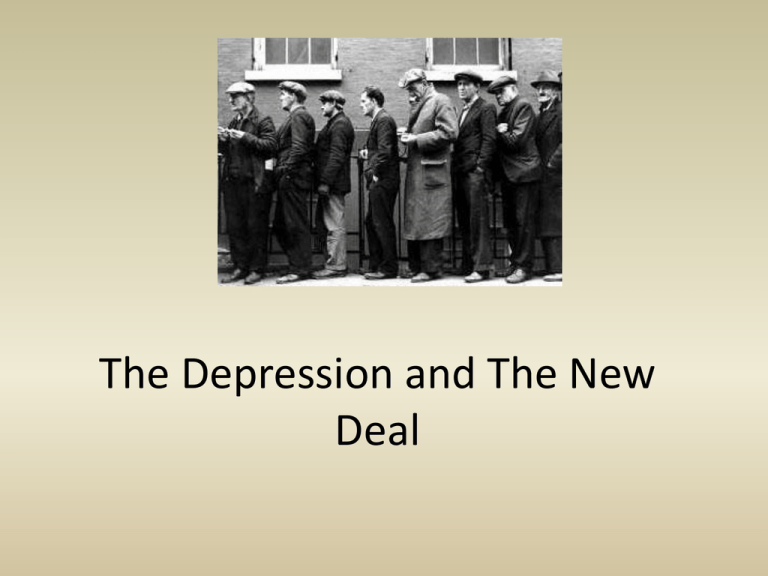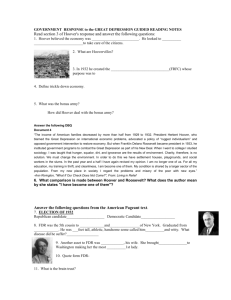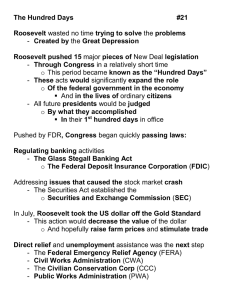The Depression and The New Deal
advertisement

The Depression and The New Deal Causes of the Depression • Stock Market Crash • Uneven Distribution of Wealth • Overproduction in industry and agriculture Causes of the Depression, cont’d • Farmers’ income down • Farmers can’t pay back loans • Banks also lost money on stock purchase • Banks begin to close The Great Depression in Numbers • Between 1929 and 1932 86,000 businesses closed and 9000 banks closed • Unemployment went from 3.2% in 1929 to 24.9% in 1932 • Stocks lost 89% of their value The Dust Bowl The Dust Bowl • Over 350,000 “Okies” moved from that region to California in the early 1930s. • John Steinbeck wrote about these migrants in The Grapes of Wrath. This Drought-Stricken Land by Alexander Hogue The Crucified Land by Alexander Hogue Hoover’s Response to Depression • Hoover was a strong believer in “rugged individualism” • Reconstruction Finance Corporation (1932)— companies and railroads • Business gets help; poor do not • “Hoovervilles” The Bonus Army • 1924 legislation • Wanted early payment • 1932 Veterans occupy DC (20,000) • Hoover opposed • Ordered Army to tear down shacks Election of 1932 • Hoover was renominated as the Republican candidate • Hoover --insensitive • Franklin Delano Roosevelt, former Governor of New York, was Democratic nominee Election of 1932 • Hoover did not believe in the government creating public works programs to relieve unemployment • Americans understood that voting for FDR would mean a change in federal policy • FDR won 57% of the vote and 42 of 48 states FDR Wins Election 1932 • “I pledge you, I pledge myself, to a new deal for the American people.” 3 Rs • Relief (for people out of work) • Recovery (for businesses & the economy) • Reform (of American economic institutions) Destitute Alphabet Agencies Industry Farming Stock Market Banking Find out more - Internet. First Hundred Days • • • • March 4, 1933 Inaugural address Gathers “brain trust” Design programs for 3 Rs First Hundred Days • Emergency Banking Relief Act • Bank holiday Run on the Banks First Hundred Days • Civilian Conservation Corps • Tennessee Valley Authority • Agricultural Adjustment Act • National Industrial Recovery act • Glass-Steagall Banking Act FDR’s First New Deal • First Hundred Days programs—part of First New Deal • Securities and Exchange Commission • Federal Housing Administration • U.S. drops gold standard FDR’s Second New Deal • Much of the First New Deal was devoted to Recovery • Summer of 1935 more legislation begun for Relief and Reform Second New Deal (1934-35) • Works Progress Administration • Social Security Act • Wagner Labor Relations Act Works Progress Administration Works Progress Administration Works Progress Administration WPA—Federal Arts Projects WPA—Federal Arts Projects WPA—Federal Arts Projects WPA—Federal Arts Projects WPA—Federal Arts Projects WPA—Federal Arts Projects WPA—Federal Arts Projects Oral Histories Former Slave Interviews Opponents to the New Deal & FDR • • • • Father Charles Coughlin Dr. Francis Townsend Huey Long Election of 1936 Supreme Court Problems • 1935—Schechter v. U.S. rules NIRA unconstitutional • Later AAA ruled unconstitutional also (U.S. v Butler) • FDR proposes “Court reform bill.” Supreme Court problems • Plan: New justices (6) • Congress & public opposed • FDR’s biggest defeat • Supreme Court upholds program • FDR eventually appoints a total of nine Justices Recession of 1937-38 • Economy looks better in 1937 • FDR reduces funding for New Deal • Economy goes into recession again • Using advice from John Maynard Keynes, FDR adds a third round of New Deal spending in 1938 The New Deal and the Role of the Federal Government • Completely changed role of government in the welfare of the average American • Finished out Progressive Era reforms • Federal government became largest single employer • Had a role in schools, farms, retired people and more The New Deal and Labor • Labor union membership increased • John L. Lewis creates Congress of Industrial Organizations (CIO) • The Wagner Act The New Deal and African Americans • The New Deal didn’t confront racism (Scottsboro Boys trial) • CCC camps were segregated • Blacks become largely Democratic • Eleanor Roosevelt— vocal supporter of minority rights The New Deal and Women • New Deal programs were almost exclusively for men • CCC only hired men • Eleanor Roosevelt again became a symbol of a new kind of woman • Frances Perkins, first female cabinet member, served as Secretary of Labor from 1933-45. Success or Failure? 1. Reduced unemployment by 7 million 2. Soil conservation initiated 3. The Stock Market and banks recovered. 4. Transformed the Tennessee valley. 5. Roosevelt was re-elected. 1. Still 6 million out of work in 1941. 2. The numbers fell due to enlistment and rearmament in WW2. 3. Black people were segregated from white. 4. Women were excluded from the New Deal. 5. Tennessee benefited but many areas were still suffering.




